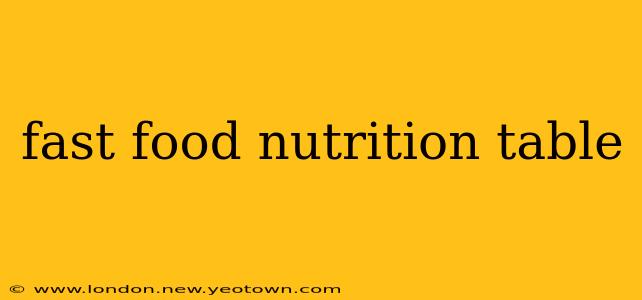Fast food. The siren song of convenience, whispering promises of quick meals and satisfying cravings. But beneath the alluring aroma of fries and the sizzling burgers lies a nutritional landscape that can be tricky to navigate. This guide aims to illuminate that landscape, providing you with the tools to make informed choices when faced with the tempting offerings of fast-food restaurants. We'll explore the nutritional information often hidden in plain sight, helping you understand what you're consuming and how to make healthier selections.
What are the nutritional values of common fast food items?
This is a broad question, as the nutritional values vary wildly depending on the specific item, the restaurant, and even the location. A Big Mac from McDonald's will have a different calorie count and macronutrient breakdown than a Whopper from Burger King. Instead of providing a single, inaccurate table, we'll address this by focusing on general categories and highlighting key things to watch out for.
Generally, fast food is high in calories, fat (especially saturated and trans fats), sodium, and added sugars. Items like burgers, fries, and fried chicken are notorious calorie bombs. Even seemingly "healthier" options, like salads, can be surprisingly high in calories and fat if laden with creamy dressings and croutons.
Always check the nutritional information panel available on restaurant websites or in-store. This is your best bet for accurate data specific to the item and restaurant you're considering. Pay close attention to serving sizes – those listed nutritional values are usually for a single serving, and many fast-food portions are significantly larger.
How many calories are in a typical fast food meal?
A "typical" fast food meal can easily range from 800 to 1500 calories or more, depending on your choices. This often includes a burger, fries, and a sugary drink. Consider this: a large soda alone can easily contain 200-300 calories, and those fries can add another 400-500. Adding a high-calorie burger to this mix quickly surpasses recommended daily calorie intakes for many individuals.
What are the healthiest options at fast food restaurants?
While "healthy" is subjective and depends on individual dietary needs, generally, some better options include:
- Grilled items: Opting for grilled chicken or fish sandwiches over fried alternatives significantly reduces fat and calorie content.
- Salads (with caution): Salads can be a decent choice, but be mindful of dressings and toppings. Choose light vinaigrettes instead of creamy dressings and be wary of added croutons, cheese, and bacon.
- Fruit and vegetables: Many restaurants offer fruit cups or side salads. These are good additions to a meal if you’re looking for more fiber and vitamins.
- Smaller portions: Order smaller sizes of fries or other sides to reduce your overall calorie intake.
- Water or unsweetened beverages: Ditch the sugary sodas and opt for water, unsweetened tea, or diet soda.
Are there any healthy fast food chains?
The concept of a truly "healthy" fast-food chain is debatable. Most fast-food establishments prioritize speed and affordability, often resulting in menus featuring high-calorie, processed foods. However, some chains are making efforts to incorporate healthier options into their menus. Many now offer salads, grilled chicken, and fruit cups, allowing for slightly healthier choices. However, careful scrutiny of nutritional information remains essential.
How can I make healthier choices when eating fast food?
Making healthier choices at fast-food restaurants comes down to mindful decision-making:
- Check the nutritional information: This is crucial for understanding the calorie, fat, sodium, and sugar content of your choices.
- Prioritize lean proteins and whole grains: Look for grilled options instead of fried, and choose items with whole grains whenever possible (though this is often limited in fast-food settings).
- Control portion sizes: Share a meal with a friend, or order a smaller size to reduce your overall calorie intake.
- Choose healthy sides: Opt for fruit, vegetables, or a small side salad instead of fries or other high-calorie sides.
- Drink water or unsweetened beverages: Skip the sugary drinks, which are a major source of empty calories.
Fast food can be part of a balanced diet, but it should be consumed in moderation and with awareness. By understanding the nutritional content and making informed choices, you can enjoy the convenience of fast food without compromising your health. Remember that regular exercise and a balanced overall diet are crucial for maintaining good health, regardless of your fast-food choices.

